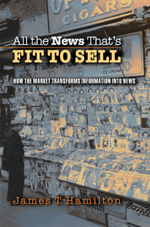 [Here’s Zach’s review of Chapter 2 of this month’s Nieman Journalism Lab Book Club selection. For more info, check here. —Ed.]
[Here’s Zach’s review of Chapter 2 of this month’s Nieman Journalism Lab Book Club selection. For more info, check here. —Ed.]
The New York Sun was one of the first non-partisan newspapers in the United States, and it might have been the country’s last partisan newspaper as well. What happened in the intervening 175 years was the full-circle transformation of American publishing.
To be clear, there have been two New York Suns: one that printed from 1833 until 1950, reigning for a time as the most important daily in New York, and another, unrelated except by name and motto, that published between 2002 and 2008. The original Sun’s founder, Benjamin Day, credited his newspaper’s success in the middle of the 20th century to a new invention, the rotary press, which upended the model of printing that had reigned since Gutenberg. “The development of presses with runs of 25,000 sheets or more per hour meant a single newspaper could supply a significant portion of a city’s readers,” writes James Hamilton in chapter two of All the News That’s Fit to Sell. The increased output, along with a decline in the cost of paper, meant that publishers like Day didn’t need to rely on expensive subscriptions like typical American newspapers of the time. Instead, he charged a penny.

The Sun also broke from its competitors in political perspective — or rather, by choosing not to have one. According to Hamilton’s data, 87 percent of daily newspapers in large American cities were allied with either the Democrats or the Republicans in 1870. But the Sun pitched itself this way to advertisers in 1880:
In its comments on men and affairs, THE SUN believes that the only guide of policy should be common sense, inspired by genuine American principles and backed by honesty of purpose. For this reason it is, and will continue to be, absolutely independent of party, class, clique, organization, or interest. It is for all, but of none.
Hamilton sets out to argue that the non-partisan stance adopted by the Sun — and, increasingly, most major-market dailies between 1870 and 1900 — had little to do with journalistic ethics or a commitment to the truth. Like charging a penny, political independence was a business calculation intended to reach the largest possible audience. The newer, faster presses cost more money, and publishers could no longer afford to limit their readerships by taking a narrow point of view.
And while that’s been argued before, Hamilton adds the rigor of his field, economics, to demonstrate the effect more conclusively. By 1900, he finds, just 50 percent of dailies in large American cities still considered themselves Democratic or Republican. The increasing collection of independent newspapers charged premiums to advertisers, employed more journalists, and were more likely to establish Washington bureaus — laying the groundwork, essentially, for the business of 20th-century newspapers.
It is often said that the crisis now upending print periodicals is secular rather than cyclical, and that’s true enough. But if you take a long enough view, it certainly seems as though the American press is returning to something like the early 19th century before Benjamin Day’s Sun broke the model. It’s been said before, but Internet publishing is a technological innovation at least on the order of the rotary press, and there’s probably something we can learn about our current situation from that earlier transformation. There are plenty of comparisons to be made.
In one of my favorite tables in chapter two, Hamilton counts the average number of newspapers and their circulation in American cities between 1870 and 1900. He finds that in 1870, dailies in medium-sized cities had a combined circulation of .25 copies per person, which grew to .54 by 1900 for the reasons described above. So I ran some numbers from present-day Seattle, a medium-sized city experiencing a similarly dramatic transformation among its daily newspapers. The results are uncanny: The Seattle Times and Post-Intelligencer currently have a combined circulation of .53 copies per person — or pretty much exactly the situation in 1900. When the P-I folds its print edition in March, Seattle will return to an average daily circulation of .33 per person, just slightly above where the number was in 1870 before everything changed. (The number may be higher for a time if former P-I subscribers move to the Times.) The common refrain that bloggers are the pamphleteers of yore starts to gain more heft when the data harkens back to the earlier era, too.

Which brings us back to the Sun — this time the second one, which made an impressive but unsuccessful seven-year run at profitability this decade. Though its news pages were smartly written and largely without bias, the new Sun’s publisher, Seth Lipsky, called it a “right-of-center broadsheet” and sought to cover topics like Israeli foreign policy with a sympathetic eye. Its print audience was a small subset of like-minded conservatives and Orthodox Jews — in other words, the kind of partisan niche that the rotary press had long ago rendered unprofitable and for which the Internet promises a new refuge.